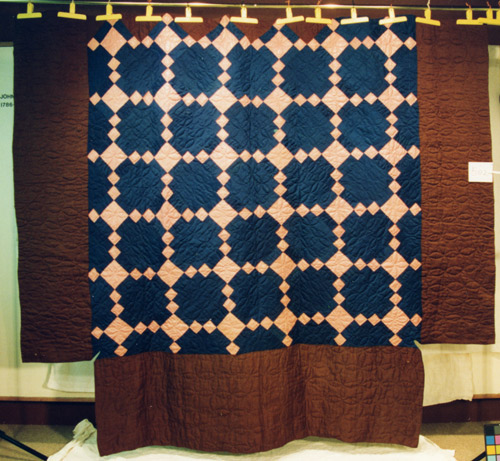
QUILT INDEX RECORD
23-19-277
Where are the records for this quilt housed?
University of Rhode Island
Who documented this quilt?
Rhode Island Quilt Documentation Project; Rhode Island Historical Society Collection
Rhode Island Quilt Documentation Project Number:
502
Alternate inventory control number:
RIHS 1958.21.1
Person filling out this form is:
Quilt owner; Quilt collector
When was the form filled out?
04/05/1993
Choose the best description of the source to the quilt:
Quilt owner; Quilt collector
If you are the quilt owner, how did you acquire this quilt?
Other
Describe the relationship to the quilt's maker:
Rhode Island Historical Society provided information given to them by the donor.
This is a:
Finished quilt
Quilt's title:
Single Irish Chain
How wide is the quilt?
147 inches
How long is the quilt?
94 inches
Shape of edge:
Straight
Shape of corners:
T-cutout
What color is the quilt?
Red; Brown; Blue or Navy
Overall color scheme:
Multicolor
Quilt's condition:
Good/moderate use
Damage:
Stains
Time period:
1800-1849
Family/owner's date for quilt:
1842-1846
Date estimated by an antique dealer, quilt historian or appraiser:
1800-1825
Describe the quilt's layout:
Block pattern
Number of quilt blocks:
72
Size of quilt blocks:
8 1/2-9 inches x 8 1/2-9 inches
Arrangement of quilt blocks:
On point or rotated on 45 degrees
Spacing of quilt blocks:
Alternating with plain squares; Side by side
Number of different block patterns used in the quilt:
1
What is the shape of the quilt blocks?
Squares
Number of borders:
1
Describe the borders:
Plain brown border on three sides with corner cut out for four-poster bed. 16 5/8 inches wide on the sides and 21 3/4 inches wide on the bottom.
Fiber types used to make the quilt top:
Wool
Fabric types used to make the quilt top:
Glazed
Fabric styles used in the quilt top:
Solid/plain
Describe the fibers or fabrics in the quilt top:
Calamanco
Piecing techniques used to make the quilt top:
Hand Piecing
Can you feel or see paper on the quilt that was used as a construction aid?
no
Materials used to make the back:
Linen; Cotton
What color is the back of the quilt?
White
Number of pieces of fabric in the quilt back:
2
Describe the back:
Hand sewn
How is the binding made?
Edges turned in/ no separate binding
What kind of filling is used in the quilt?
Cotton
How are the layers held together?
Hand quilting
Thread type used for the quilting:
Single
Color of thread used in the quilting:
White, Blue, & Brown
Number of quilting stitches per inch, place 1:
6 per inch
Quilting designs used, overall motifs:
Other; All-over-design
Describe the quilting designs used:
Concentric Cirlces
Features or notes about the quilt's appearance, materials, or construction:
Not only are the corners in a T-cut out design, but the corners of the central part of the quilt have been cut into to increase the separation.
Quilt top made by:
Staples, Lavina Leavitt
Quilted by:
Staples, Lavina Leavitt
Where the quilt was made, city:
Auburn
Where the quilt was made, state:
Maine (ME)
Where the quilt was made, country:
United States
How was this quilt acquired?
Other
Tell the story of how the quilt was obtained:
Donated to the Rhode Island Historical Society in 1958 by Sarah Staples, the quiltmaker's granddaughter.
Why was the quilt made?
Unknown
The quilt was made to be used for:
Unknown
Quilt is presently used as:
Museum collection
Where did the maker get their materials?
Unknown
Where did the maker find their pattern?
Public domain/traditional pattern
Where did the quiltmaker find the pattern for the quilting design on the quilt?
Public domain
Ownership of this quilt is:
Public Museum, Library or Institution
Quilt owner's name:
Rhode Island Historical Society
Quilt owner's city:
Providence
Quilt owner's state:
Rhode Island (RI)
Quilt owner's country:
United States
Quiltmaker's maiden name:
Leavitt
Quiltmaker's gender:
Female
Quiltmaker's birthplace, country:
United States
Who photographed this quilt?
RIQDP
Access and copyright information:
Restricted
Copyright holder:
Linda Welters
Cite this Quilt
Staples, Lavina Leavit. Single Irish Chain. 1800-1849. From University of Rhode Island, Rhode Island Quilt Documentation Project; Rhode Island Historical Society Collection. Published in The Quilt Index, https://quiltindex.org/view/?type=fullrec&kid=23-19-277. Accessed: 04/20/24